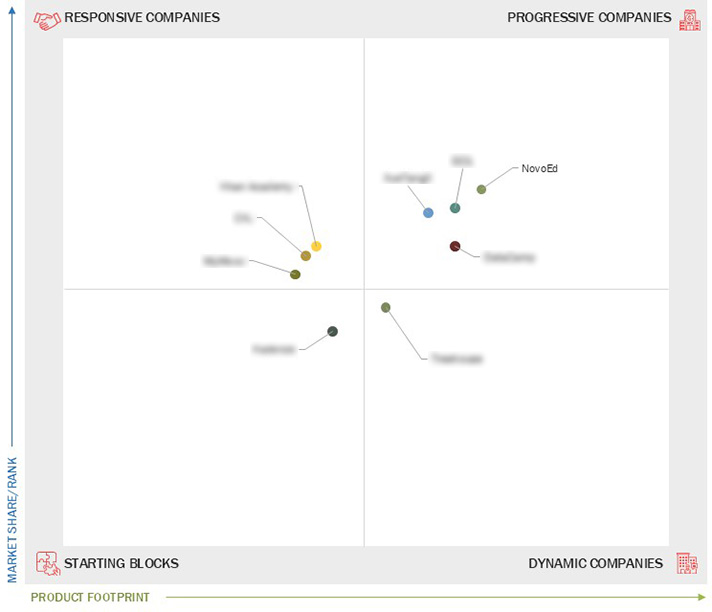Comparing 9 vendors in Digital Education Startups across 0 criteria.
Digital education is transforming learning by offering scalable, flexible, and accessible solutions through internet-based platforms. It enables students and professionals to upskill efficiently without the constraints of traditional classroom settings. The market is driven by technological advancements, strategic partnerships, and the need for cost-effective education. Despite challenges like lack of personalized guidance and economic uncertainties, digital platforms continue to grow, supported by institutions and governments. Companies are adapting by offering free courses and targeting academic sectors to maintain resilience during downturns.
Market Leadership Quadrant
1.1 Study Objectives
1.2 Market Definition
1.2.1 Inclusions and Exclusions
1.3 Market Scope
1.3.1 Market Segmentation
1.3.2 Years Considered
1.4 Currency Considered
1.5 Stakeholders
1.6 Summary of Changes
2.1 Introduction
2.2 Market Dynamics
2.2.1 Drivers
2.2.1.1 Growing demand for adaptive technology-driven personalized
learning
2.2.1.2 Gamification enhancing student engagement in learning
2.2.1.3 Rising need for upskilling and reskilling
2.2.1.4 Increasing IoT integration in digital education for real-
time engagement
2.2.2 Restraints
2.2.2.1 Infrastructure shortage in rural areas
2.2.2.2 Prolonged screen time
2.2.3 Opportunities
2.2.3.1 Transforming microlearning and modular learning with
digital education
2.2.3.2 Localized content creation to boost course completion rates
2.2.3.3 Blockchain integration in education systems
2.2.3.4 Corporate-academic EdTech partnerships
2.2.4 Challenges
2.2.4.1 Insufficient interaction in virtual classrooms hindering
student engagement
2.2.4.2 Inadequate teacher training hampering effective integration
of digital tool
2.3 Ecosystem Analysis
2.4 Supply Chain Analysis
2.5 Patent Analysis
2.6 Technology Analysis
2.6.1 Key Technologies
2.6.1.1 Learning management systems (LMS)
2.6.1.2 Cloud-based platforms
2.6.2 Complementary Technologies
2.6.2.1 Blockchain
2.6.2.2 Natural learning processing (NLP)
2.6.3 Adjacent Technologies
2.6.3.1 AR & VR
2.6.3.2 Gamification & simulation
2.7 Porter’s Five Forces Analysis
2.7.1 Threat of New Entrants
2.7.2 Threat of Substitutes
2.7.3 Bargaining Power of Buyers
2.7.4 Bargaining Power of Suppliers
2.7.5 Intensity of Competitive Rivalry
2.8 Key Conferences and Events, 2025
2.9 Trends/Disruptions Impacting Customer Business
2.10 Business Model Analysis
2.10.1 Subscription-Based Model
2.10.2 License-Based Model
2.10.3 Freemium Model
2.11 Investment and Funding Scenario
2.12 Impact of AI/Gen AI on Digital Education Market
2.12.1.1 WorkRamp
2.12.2 Case Study
2.12.2.1 Use of generative AI by Moderna to drive pharmaceutical
advancements
2.13 Impact of US Tariff – Digital Education Market
2.13.1 Introduction
2.13.2 Key Tariff Rates
2.13.3 Price Impact Analysis
3.1 Introduction
3.2 Key Player Strategies/Right to Win, 2022–2025
3.3 Market Share Analysis, 2024
3.4 Revenue Analysis, 2020–2024
3.5 Company Evaluation Matrix: Startups/SMEs, 2024
3.5.1 Progressive Companies
3.5.2 Responsive Companies
3.5.3 Dynamic Companies
3.5.4 Starting Blocks
3.5.5 Competitive Benchmarking: Startups/SMEs, 2024
3.5.5.1 Detailed list of key startups/SMEs
3.5.5.2 Competitive benchmarking of key startups/SMEs
3.6 Company Valuation and Financial Metrics
3.6.1 Company Valuation
3.6.2 Financial Metrics
3.7 Brand/Product Comparison
3.8 Competitive Scenario
3.8.1 Product Launches and Enhancements
3.8.2 Deals
4.1 NOVOED
4.1.1 Business overview
4.1.2 Products/Solutions/Services offered
4.1.3 Recent developments
4.2 XUETANG
4.2.1 Business overview
4.2.2 Products/Solutions/Services offered
4.2.3 Recent developments
4.3 KHAN ACADEMY
4.3.1 Business overview
4.3.2 Products/Solutions/Services offered
4.3.3 Recent developments
4.4 KADENZE
4.4.1 Business overview
4.4.2 Products/Solutions/Services offered
4.4.3 Recent developments
4.5 TREEHOUSE
4.5.1 Business overview
4.5.2 Products/Solutions/Services offered
4.5.3 Recent developments
4.6 CXL
4.6.1 Business overview
4.6.2 Products/Solutions/Services offered
4.6.3 Recent developments
4.7 GO1
4.7.1 Business overview
4.7.2 Products/Solutions/Services offered
4.7.3 Recent developments
4.8 DATACAMP
4.8.1 Business overview
4.8.2 Products/Solutions/Services offered
4.8.3 Recent developments
4.9 MY MOOC
4.9.1 Business overview
4.9.2 Products/Solutions/Services offered
4.9.3 Recent developments


 富途牛牛
富途牛牛
 Sep 2025
Sep 2025

